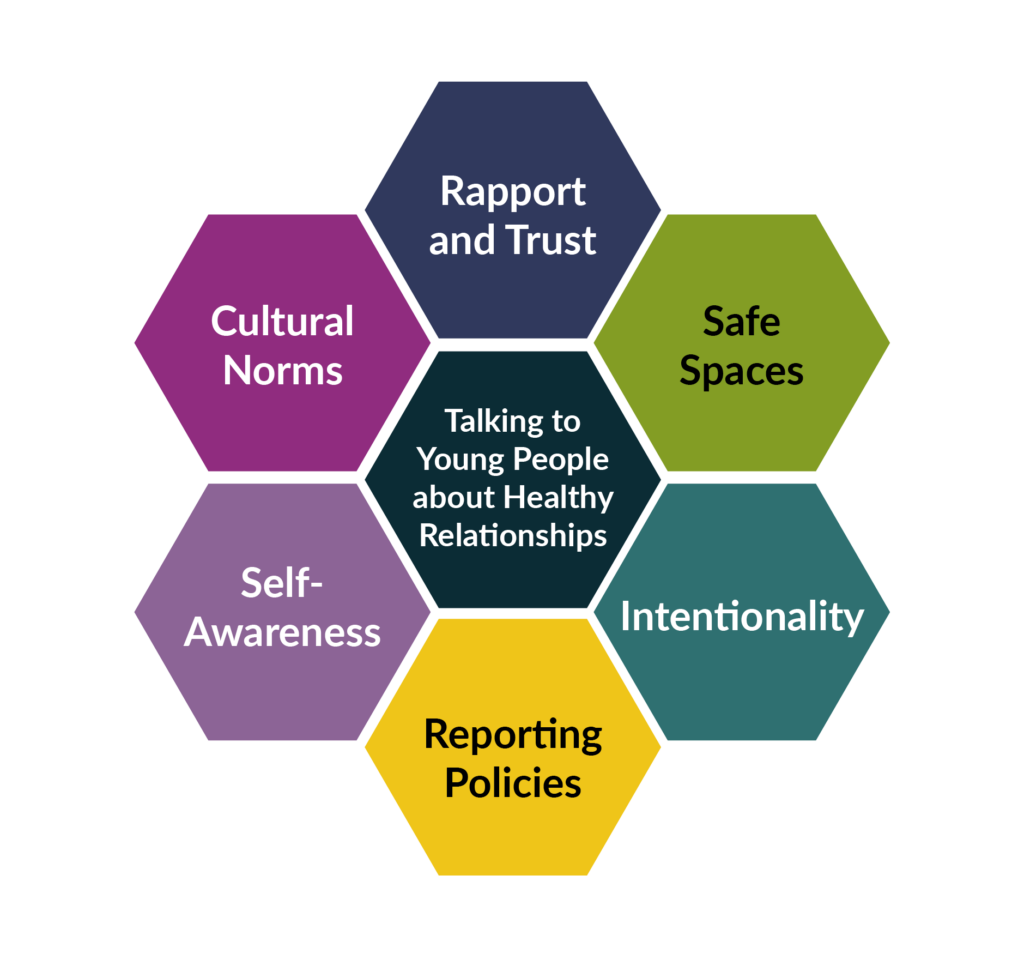Laying the Foundation to Talk to Young People About Healthy Relationships
When talking with youth about healthy romantic relationships, consider how well you are prepared for the conversation.16 This tool outlines six conditions that may help you talk to young people about healthy relationships, why those conditions are important, and how you can cultivate these conditions for the youth you support.
You can establish the foundation for talking to young people about healthy relationships when you:

- Develop rapport and trust with the young person.
- Create a welcoming and private space.
- Prepare for, engage in, and follow up with youth intentionally.
- Remain self-aware and willing to reflect on your own assumptions.
- Maintain your knowledge of state-mandated reporting policies.
- Pay attention to cultural norms.
Click here for guidance on why each condition is important and how to create the condition.
For more information on laying the foundation for talking about healthy relationships with youth, see section four of this toolkit: Additional Resources for Talking With Youth About Healthy Romantic Relationships.17-36
Conversation Starters for Talking With Youth About Healthy Romantic Relationships
Communication, boundaries/limits, and shared power are key components of healthy romantic relationships that are critical for young people who experience the child welfare and/or juvenile justice systems, homelessness, and/or disconnection from school and work—according to the young people and youth-supporting professionals who advised this work.
You can use these conversation starters to initiate discussions with young people. For each component—communication, boundaries/limits, and shared power—you will find a definition and suggested conversation prompts to help you start the conversation, continue the discussion, and follow up after the conversation. These prompts are not exhaustive.b
Communication
Communication is how partners in a relationship express their thoughts and feelings, both verbally and nonverbally.37,38 Healthy communication includes active listening, honesty, emotional regulation, and self-awareness.39,40 Preferences and styles may vary from youth to youth depending on culture and experiences.41-43
Experience in the child welfare and/or juvenile justice systems, homelessness, and/or disconnection from school and work may limit young people’s opportunities to learn communication skills and practice these in safe relationships with parents, siblings, and friends due to frequent moves or unstable placements. Through these conversation starters, you can help young people reflect on their communication styles and strengthen their verbal and nonverbal communication skills.
-
Use these conversation starters to talk with youth about communication in their romantic relationships.
Boundaries/limits
Boundaries/limits are an individual’s expectations and limits of what behaviors are acceptable or not acceptable within their relationships.44 Individuals generally have physical, material, mental or intellectual, and emotional boundaries/limits.45 Understanding and recognizing boundaries/limits is essential for establishing and maintaining a healthy romantic relationship. Healthy boundaries/limits allow youth to feel comfortable with expectations in their relationships.46
Time spent in the child welfare and/or juvenile justice systems, homelessness, and/or disconnection from school and work can leave young people with little control over how they are treated in those relationships and their lack of autonomy within those relationships.47 Therefore, youth may have less practice establishing boundaries/limits in relationships and need additional help figuring out their boundaries/limits and communicating those to other people.
-
Use these conversation starters to talk with young people about boundaries/limits in their romantic relationships.
Shared power
Shared power means that partners in a relationship support and respect one another and have balanced, mutually agreed-upon roles and responsibilities.48-50 People in relationships with shared power tend to be more satisfied in their relationship and may experience better mental health.51
Talking about and understanding shared power in romantic relationships is complex. For example, shared power is influenced by behaviors and biases related to numerous factors such as gender identity, sexual orientation, race, and disability status.52 Youth experiencing the child welfare and/or juvenile justice systems, homelessness, and/or disconnection from school and work may have limited examples of shared power in relationships due to a lack of stability in their homes and living arrangements and few opportunities to openly discuss power-sharing.
-
Use these conversation starters to talk with young people about shared power in their romantic relationships.
Dos and Don’ts for Talking With Youth About Healthy Romantic Relationships
You can use these dos and don’ts to guide your conversations with young people about healthy romantic relationships. Approach each conversation with empathy, willingness to listen and learn, and commitment to improve.c
For more information on dos and don’ts for talking with youth about healthy relationships, see section four of this toolkit: Additional Resources for Talking With Youth About Healthy Romantic Relationships
The following list of recommendations is not exhaustive but provides a starting point for talking with young people about healthy romantic relationships:
- Create an open and judgement-free zone.
- Help young people explore their experiences rather than labeling them.
- Validate young peoples’ feeling and experiences.
- Approach conversations with an open mind.
- Use a trauma-informed lens.
- Respect youth’s privacy and be transparent about limits to transparency.
The table below provides examples of how to work toward each condition. Download the table here.
| DOS | DON'TS | ||
 |
DO ask nonjudgemental, open-ended questions. “Can you walk me through the interaction and how it made you feel?” |
 |
DON'T use language that can be interpreted by the young person as implying blame or shame. “It might not have been productive to react like that. You probably should have reacted a different way.” |
 |
DO ask nonjudgemental, open-ended questions. “Can you walk me through the interaction and how it made you feel?” |
 |
DON'T rely on black and white labels. “Your partner was being abusive toward you.” |
 |
DO ask nonjudgemental, open-ended questions. “Can you walk me through the interaction and how it made you feel?” |
 |
DON'T trivialize experiences, fears, needs, or wants. "It’s unrealistic to set a boundary to prevent disagreement or arguments from ever happening.” |
 |
DO ask nonjudgemental, open-ended questions. “Can you walk me through the interaction and how it made you feel?” |
 |
DON'T make assumptions or generalizations about what a young person does or does not know. “Young people are too naïve and inexperienced to recognize when they’re in an unhealthy relationship.” |
 |
DO ask nonjudgemental, open-ended questions. “Can you walk me through the interaction and how it made you feel?” |
 |
DON'T ignore complexities of a situation. “You should have left the relationship as soon as the problems started.” |
 |
DO ask nonjudgemental, open-ended questions. “Can you walk me through the interaction and how it made you feel?” |
 |
DON'T assume young people know what must be disclosed or that everything is confidential. “Don’t worry, everything you tell me will stay between us.” |
Additional Resources for Talking With Youth About Healthy Romantic Relationships
You can use the resources below to access additional information about components of healthy relationships, building communication skills, boundaries/limits, and shared power.
| Resource name and link | Resource description | Use this resource to … |
|---|---|---|
| National Healthy Marriage Resource Center, The Annie E. Casey Foundation, and Innovation Center for Community and Youth Engagement (2019). Relationships matter: Strengthening vulnerable youth | This report reviews the importance of healthy relationships among youth and how to discuss them with youth. | Gain knowledge and comfort about healthy romantic relationships. |
| John Hopkins University (2020). 12 elements of healthy relationships | This blog explores elements of healthy relationships and provides links to resources for additional information. | Gain additional examples of how to talk with youth about healthy relationships. |
| Youth.gov (n.d.). Characteristics of healthy and unhealthy relationships | This webpage describes characteristics of healthy relationships for teens and unhealthy relationship characteristics. | Gain knowledge of healthy relationships and signs of healthy and unhealthy relationships. |
| Forbes Health (2024). How to communicate in a relationship, according to experts | This report reviews the importance of healthy relationships among youth and how to discuss them with youth. | Gain knowledge and comfort about healthy romantic relationships. |
| Positive Psychology (2024). How to Set Healthy Boundaries and Build Positive Relationships | This blog explores elements of healthy relationships and provides links to resources for additional information. | Gain additional examples of how to talk with youth about healthy relationships. |
| Therapist Aid (2016). What are personal boundaries? | This report reviews the importance of healthy relationships among youth and how to discuss them with youth. | Gain knowledge and comfort about healthy romantic relationships. |
| Mass.Gov (n.d.).Boundaries in healthy relationships | This blog explores elements of healthy relationships and provides links to resources for additional information. | Gain additional examples of how to talk with youth about healthy relationships. |
| OurPath (2021). Healthy boundaries for partners of trans people | This webpage describes characteristics of healthy relationships for teens and unhealthy relationship characteristics. | Gain knowledge of healthy relationships and signs of healthy and unhealthy relationships. |
| Eastland County Crisis Center (n.d.). Relationship Equality Wheel for Teens | This report reviews the importance of healthy relationships among youth and how to discuss them with youth. | Gain knowledge and comfort about healthy romantic relationships. |
| Love is Respect (n.d.). Power and Control | This blog explores elements of healthy relationships and provides links to resources for additional information. | Gain additional examples of how to talk with youth about healthy relationships. |
| Love in Respect (n.d.). 4 things that make a relationship healthy or unhealthy | This webpage describes characteristics of healthy relationships for teens and unhealthy relationship characteristics. | Gain knowledge of healthy relationships and signs of healthy and unhealthy relationships. |
Suggested citation: Rosenberg, R., Naylon, K., Simone-Woods, N., Rust, K., Beckwith, S. (2024). Crucial Conversations about Healthy Romantic Relationships: A Toolkit for Youth Supporting Professionals. Child Trends.
[a] The domains were identified by a group of young people with lived expertise, program administrators and direct service providers who support them, and other experts on sexual and reproductive health working with systems-involved youth, youth experiencing homelessness, and disconnected youth.
[b] All prompts in this section of the toolkit and the associated PDF are informed by the research literature on healthy romantic relationships.
[c] Factors such as cultural norms play an important role in conversations about healthy romantic relationships. For more information about cultural considerations to keep in mind when talking about healthy relationships with youth, see “Laying the Foundation.”
-
References
-
Acknowledgements
